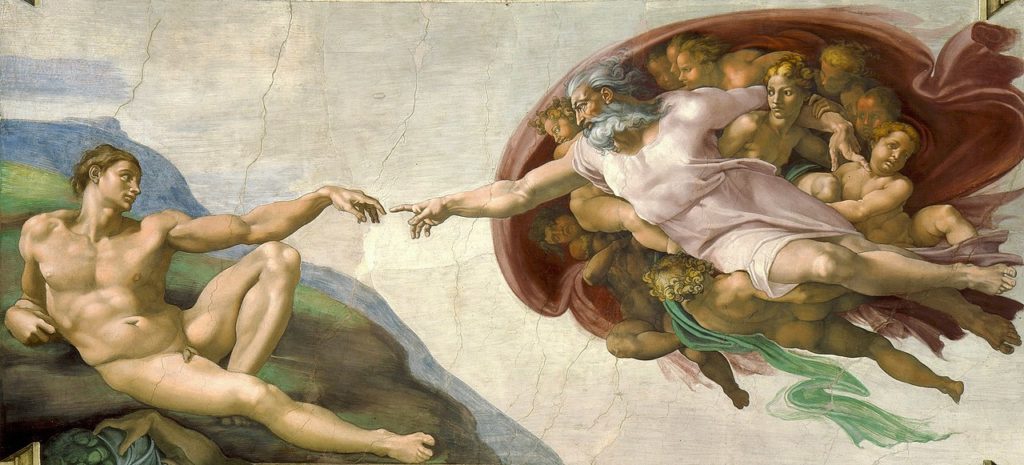The decline in religious belief in the West is remarkable in light of the overwhelming evidence from human history and from anthropology that homo sapiens is a religious species. There are very sophisticated intellectual accounts of why ours is increasingly a secular age, but I contend that there is one main reason for it–the estrangement of modern existence from nature. Most people today hardly spend any time outdoors, and when we do we are more likely to be walking or running on sidewalks or playing sports on an urban or suburban playing field. Confined within our houses and offices, we check our mobile phones, search the internet on our laptops, or watch TV. If we spend nearly all our lives inside buildings and vehicles and feel most at home in a world of concrete, roads, and the worldwide web, then it is no wonder that we do not believe in God.
In the Jewish and Christian faith, “God” is the Creator, and, moreover, God is known through the things that God has made. The psalmist sings, “The heavens are declaring the glory of God; and the firmament proclaims his handiwork” (Psalm 19:1 NRSV).
It is still true that “ever since the creation of the world [God’s] eternal power and divine nature, invisible though they are, have been understood and seen through the things he has made” (Romans 1:20 NRSV) even though the history of religions also demonstrates that we human beings have “exchanged the glory of the immortal God for images…” (Romans 1:23 NRSV). But, if we live our whole lives as much as possible isolated from the natural world, then it is no surprise at all that there is now a decline in religious belief. This is a problem not only for the religions themselves, but also for human beings if it is true, as all the evidence indicates, that homo sapiens has evolved to be a religious species. There can be no human flourishing apart from nature nor apart from the experience of God that is mediated through nature. In this day and age, preachers should stop complaining about people missing church to spend time in nature by falsely claiming that it is not true that people “feel closer to God in nature,” but they should instead praise people’s insight into the spiritual connection they feel in nature and encourage it while also persuading them that without participating in Christian liturgy we shall not rightly perceive and understand the God we encounter in nature.
The scriptures open with the declaration that God is our Creator. There are two narratives of God’s creative work in the book of Genesis. The second and older one, Genesis 2:4b ff., focuses on the existential realities of human existence, whereas the first and later narrative, Genesis 1:1-2:4a, offers a grand vision of God’s creation of the whole cosmos. Neither of these narratives were written to explain empirically how the natural world has come into being and developed, but both of them make the theological claim that the God of Israel is the source of the origin of all things. This theological claim was related to the life situations in which the narratives were written, such as strengthening the faith of the Jews during the exile in Babylon, but faith in God as Creator came from the people of Israel reflecting on their experience of God in nature in light of the history of their relationship with God as God’s chosen people. Like us, the writers could only express their theological insights against the background of the cosmogony of their times, but their understanding of God has survived the development of our empirical knowledge of the natural world since this theological understanding has proven to be coherent with ever-changing theories in the natural sciences or rather the theories have proven to be coherent with this understanding of God.
A few observations about key verses in Genesis 1:1-2:3 may illuminate the meaning of the Jewish and Christian declaration of God as our Creator. Here our understanding of these verses is governed by the doctrinal history of Christian exegesis, recognizing that in scientific study of texts many different plausible interpretations may be proposed by biblical scholars on lexical and literary grounds. Nonetheless, a theological interpretation of texts according to Christian doctrine must still be compatible with the highest critical analyses of texts.
In the beginning God created the heavens and the earth
The first verse of Genesis 1 represents the primary confession of faith by the people of Israel and of the church of Jesus Christ. Israel and the church confess that the ultimate source of everything that exists is the one true God who is Creator and Lord: “In the beginning, God created the heavens and the earth” (Genesis 1:1 NIV).
The Hebrew word for “created” is reserved only for the action of the God of Israel. It is a word that has no analogy to the techniques and artistry of human beings. Nor is it used to describe the supposed acts of the gods in whom the peoples of the nations believed. What is described is a unique act of God alone.
“The heavens and the earth” constitute a duality which symbolizes the whole of everything. In the ancient Near East, a totality was always described as a duality of opposites. The singular Greek “cosmos” and Latin “universe” are more abstract terms which represent the totality of everything. Of course, this whole of everything in Genesis is viewed from the perspective of our planetary home, the good earth.
The “beginning” pertains to the creation, that which is not God and which God creates. It has no existence without the will and power of God. God is the mystery without beginning or end, the eternal Creator who acts and speaks. The whole sense of Genesis 1:1-2:4a indicates that this “beginning” means that the beginning of the creation is absolute in the sense that there is nothing else before it except God.
There is much debate among scholars about how to construct an English translation of the first three verses of Genesis 1 since the syntax of the Hebrew constitutes several clauses that can be understood in various ways: three verses as three distinct sentences; verses one and two as one sentence and verse three as another sentence; or three verses as one whole sentence. The NRSV translates the first two verses as one sentence, and the third verse as another sentence. The NRSV of Genesis 1:1-2 is, “In the beginning when God created the heavens and the earth, the earth was a formless void and darkness covered the face of the deep, while a wind from God swept over the face of the waters.” Here the translators make judgments that allow for the interpretation of the pre-existence of a primordial chaos (“the deep”) as that which God did not create as well as a decision to translate the Hebrew word as “wind” which may also be translated as “spirit.” However, as Claus Westermann argues in Genesis I-II: A Commentary, the style employed throughout Genesis 1 supports the translation of the first verse as a complete sentence in order to emphasize that the first Hebrew clause is the main clause, and, moreover, since there is no precedent in other cosmogonies for the confession of God as the Creator of the heavens and the earth, the image of the primordial chaos borrowed from other peoples represents what the Creator posits “in the beginning” of the creation rather than as something that already exists when God creates. Therefore, translations such as the NIV are preferable to that of the NRSV. The NIV translates the first two verses as two sentences: “In the beginning God created the heavens and the earth. Now the earth was formless and empty, darkness was over the surface of the deep, and the Spirit of God was hovering over the waters.” The NIV translation of verses one and two is clearly coherent with the Christian doctrine of creatio ex nihilo, God’s act of creating all that is out of nothing, and its translation of the Hebrew word for “wind” as “spirit” is also coherent with Christian theology. It should be noticed that the NIV adheres to the tradition of English translation in the KJV and the RSV, which the NRSV normally follows but does not follow in its translation of Genesis 1:1-2. The NIV is also compatible with the translations in the NASB, the NJB, and the CEV whereas the NEB, the TEV, and the CEV are compatible with the translation in the NRSV.
This interpretation of the theology in the first saga of creation in Genesis is consistent with the scholarly consensus that the first saga is a part of the priestly source (P) of the Pentateuch. P was composed at the time of the exile of Jews in Babylon, the same period in which Deutero-Isaiah was written. In this period, the faith of Israel had reached a maturity of thought characterized by a radical monotheism by which God’s creation of the world would be viewed as absolute in the sense of creating everything from nothing. As the prophet says, “Thus says the LORD, the King of Israel, and his Redeemer, the LORD of hosts; I am the first and I am the last; besides me there is no god” (Isaiah 44:6).
As Claus Westermann says, the first sentence in Genesis is the “prelude” to the entire account of God’s creation of everything, and “the first sentence itself is really a cry of praise.”
The one complete day in the beginning
The sentence in Genesis 1:3, “And God said, ‘Let there be light’; and there was light” (NRSV), is connected to Genesis 1:1-2 the third clause in the Hebrew text. In the moving of the Spirit of God over the primordial chaos, the order and beauty of the creation has its beginning in God’s act of calling forth light. Of course, this light is different from that of the sun, moon, and stars in Genesis 1:14-19.
We associate light with both the power of existence and knowledge. There is a striking resemblance in this biblical account of the beginning of creation and the worldview of contemporary physics. Light is the energy by which all things come into existence. Moreover, the emerging universe contains within it an “information system,” so to speak, by which that which comes into existence is ordered. We discover this system of information when we perceive numbers and use them in mathematics in order to understand the structure of the universe. Moreover, as time is the primary aspect of the order of creation measured as “Day” and “Night” in Genesis, so in contemporary physics, light is the measure of time.
The account of this beginning of creation concludes in Genesis 1:4-5. Here it becomes clear that the saga of creation in Genesis 1:1-2:4a is constructed according to the Jewish week of seven days with each day commencing in the evening. God works six days, and God rests on the sabbath, the seventh day. The beginning of creation is rounded off in the statement in Genesis 1:5b, “And there was evening and there was morning, the first day” (NRSV).
It is very significant that the literal translation of the Hebrew, and also of the Septuagint, yields the information that the beginning of creation constitutes not “the first day,” but “one day.” More literal English translations, such as the NASB, render Genesis 1:5b as following, “And there was evening and there was morning; one day.”
The NRSV, and other versions such as the NIV, translate this text as “the first day” because the Hebrew for “one day” designates the beginning of a series and therefore can be understood as the first day of the week. Yet there is more to the significance of “one day” than the meaning of the first in a series. There is a completeness to this “one day” in the beginning. In his sermons on the six days of creation, The Hexameron, Basil the Great observes that the nature of time, measured in the days of a week, constitutes a kind of circle and has a completeness that resembles eternity, which belongs to the Creator alone. Basil says, “If then the beginning of time is called ‘one day’ rather than ‘the first day’, it is because Scripture wishes to establish its relationship with eternity.” God gives time to God’s creation as an appropriate complement to God’s own uncreated eternity. Furthermore, on this “one day” which marks the beginning of time and of all creation, Basil says that “the creation of the heavens and of the earth were like the foundation and the groundwork, and afterwards that an intelligent reason, as the word beginning indicates [because ‘beginning’ connotes ‘birth’], presided in the order of visible things.” Basil’s view is that this complete “one day” in the beginning contained within it all the principles for the rest of creation which unfolds in a process over time. After all, as the natural sciences disclose and as Basil says, the creation of all things “was not spontaneous, as some have imagined, but drew its origin from God.” Basil could have pointed to the transitional verse between the two sagas of creation in Genesis, Genesis 1:2a, which speaks of “the generations of the heavens and the earth,” showing that the succession of times were integral to God’s plan of creating. Similar to modern scientists, Basil conceives of the creation as an evolutionary process, but one in which the Creator lets the information God planted in the beginning to unfold in freedom. Basil even proposes that the Spirit moving over the waters was like a bird covering its eggs with her body, indicating that the “one day” was like a cosmic egg which contained the ingredients of the entire creation. Modern biblical scholars are aware of the ancient concept of a cosmic egg, but most of them do not see it in the text of Genesis. Nevertheless, it may be a helpful image to consider for grasping the meaning of the “one day” that is described in Genesis 1:5b.
“Mother Nature”
A popular term that has very ancient roots is “Mother Nature,” referring to the natural ecology of the earth as the matrix of life and nurture. If nature (a word from Latin) is understood as God’s creation, and if God’s creation is understood to be pregnant with the information planted within it by the Creator in the beginning, then the notion of Mother Nature can be affirmed in light of Genesis 1.
On the fifth day of creation, God said, “Let the waters bring forth swarms of living creatures, and let birds fly above the earth across the dome of the sky” (Genesis 1:20 NRSV). On the sixth day of creation, God said, “Let the earth bring forth living creatures of every kind: cattle and creeping things and wild animals of the earth of every kind” (Genesis 1:24) NRSV). Thus the waters of the earth and the land of the earth together are the immediate sources of all kinds of living creatures. Nature is given a certain autonomy and capacity to bring forth life because the Creator has made it with both freedom and a program of information that “lets” it “bring forth” the living things which emerge over time.
While the authors of Genesis 1 were not knowledgeable about modern natural sciences and could only employ the language of ancient cosmogonies to express their faith in God as Creator, it is interesting how well the broad strokes of their painting of the scene of creation fit with a modern scientific worldview. They first identify the oceans as the place of the emergence of life, and they also perceive that the earth as a living system is very creative and fruitful.
God’s image: Humankind
The climax of the sixth day of creation is the creation of humankind, in two complementary sexes, as the image of God: “So God created humankind in his image, in the image of God he created them; male and female he created them” (Genesis 1:27 NRSV).
What is striking about this aspect of the saga of creation is that the creation of humankind is different from the creation of all other creatures in that God himself fashioned this creature in his own image: “Then God said, ‘Let us make humankind in our own image, according to our likeness…” (Genesis 1:26a NRSV). The plural personal pronouns probably refer to God and God’s angels, “the Lord of hosts,” although the church fathers took these pronouns to be hints of the Trinity. What it means that human beings are made in the image of God is not explained. Readers of the saga are left to contemplate its meaning from their own experience, and we often identify human traits such as personhood, spirit, freedom, and capacities for love and reason as indicators of the divine image in which we are made. The fact that such traits distinguish human beings from all over living creatures, even though other animals do share to a degree in some of our capacities, coheres with the emphasis in Genesis 1 that we are marked by God’s special involvement in our coming into being as we are.
In his teaching and writing, Orthodox theologian Father John Behr emphasizes that the story of God’s making of the human being in Genesis is not completed until the story of Jesus Christ in the Gospel according to St. John. The Gospel of John opens with a grand allusion to the story of creation “in the beginning” when God creates all things by his Word. The Gospel then tells the story of Jesus Christ as the incarnation of the Word. The Gospel reaches its climax on the cross, when Jesus declares, “It is finished” (John 19:30 NRSV). When Jesus dies, what is finished? Behr claims that, whatever else it means, Jesus’ statement, “It is finished,” means that God’s creation of the true human being is finally finished in the complete life of Jesus Christ, the faithful Israelite and human being who speaks the truth of God and does the work of God.
In the saga of the creation of humankind, we are given “dominion” of all other creatures on earth. Having dominion is an aspect being created in God’s image, for we rule on the earth just as God is the ruler of all God’s creation. Our rule is exercised only in God’s name and by God’s authority, and therefore our dominion over the earth is intended to be a stewardship of the earth rather than an exploitation of it.
It must be remembered that this account of the creation of humankind is from P, the priestly source of the Pentateuch. The composers of this source were deeply committed to the divine purpose that the people of Israel be “a priestly kingdom” (Exodus 19:6 NRSV). They viewed the Jews as the distinctive people who are called to pray on behalf of all the nations and to be the means by which the nations come to know and obey God. Because a faithful Israel represents true humankind, the saga of the creation of humankind assumes that human beings are called to be the priests of creation. Our dominion over creation is exercised as a “royal priesthood” (1 Peter 2:9 NRSV) in which we pray to the Creator on behalf of all other creatures and develop a spiritual relation with all of nature as well as an ethical responsibility of stewardship of the earth.
It was very good
As the days or epochs of creation unfold, God’s pleasure with what God has made increases. By the time that the earth is ready for life, the third day of creation, the writers declare, “And God saw that it was good” (Genesis 1:12b). The same divine statement of pleasure with the creation is repeated on the fourth, fifth, and six days. By the end of the sixth day, when humankind was also created, it is written, “God saw everything he had made, and indeed, it was very good” (Genesis 1:31a NRSV).
As creatures made in God’s image to be the priests of creation who celebrate what God has done, we should exclaim, “It is very good!” Because the Creator rejoices in what he has made, we should also rejoice in God’s creation. This is our natural inclination, which is why our modern existence of estrangement from nature is so odd, and so unhealthy for us.
Our relationship to nature and to the church are not competitive. We need the church in order to know the Creator, and we need nature because, when we know our Creator, we realize that we have been made to be a part of the priesthood of creation. Gathering as the church, we pray the Great Thanksgiving:
Lift up your hearts.
We lift them up to the Lord.
Let us give thanks to the Lord our God.
It is right to give our thanks and praise.
It is right, and a good and joyful thing,
always and everywhere to give thanks to you,
Father Almighty, creator of heaven and earth.
Timothy W. Whitaker is a Retired United Methodist Church bishop who served the Florida Area.





Comment by Timothy on April 28, 2021 at 12:00 pm
This is a good explanation of God the Creator. In today’s world, people are bombarded with much information, most of which is evil, sinful and pulls (all) people away from God.
Seems any story about creation must include Satan, who has tremendous powers. Holy Scripture and our knowledgeable ministers and fellow Christians must continuously spread the light of the Word of God to this world.
Returning to the author’s theme, it’s spring; plant some flowers, start a small garden on your own or with friends, feed the birds and animals in your neighborhood, don’t litter, get away from the negative news and Facebook, start a better diet, conserve. It’s rewarding.
Comment by Timothy on April 28, 2021 at 12:25 pm
PS; While you are outside returning to nature in whatever way you can, take your dam# mask off and enjoy fresh air and sunshine. I only put on a faux mask when I enter stores which require them. Since our diets stink, ask a pharmacist or nutrition expert about supplements such as D3, Vitamin C, zinc, etc.
Comment by David on April 28, 2021 at 12:29 pm
It is odd that after being found to the “good,” over 99 percent of known species, including our fellow hominids, went extinct. We know for a fact early humans were apelike in appearance. Perhaps Michaelangelo should have shown a long hairy arm reaching out to Adam. I suppose God could have evolved along with us with a more modern appearance.
Comment by Mike on April 29, 2021 at 9:12 am
“We know for a fact early humans were apelike in appearance.” How do we know? Has anyone actually found a complete body, with hair and everything?
I remember in school science seeing a drawing supposedly showing what one of these creatures looked like, and thinking to myself, “I’ve seen that look before”. The following Sunday I went to church with my family, looked at my pastor preaching, and realized that, according to my science book, he had gone out of existence thousand, if not millions, of years before!
Comment by David on April 30, 2021 at 6:23 am
We are reaching the point where physical appearance can be predicted from DNA. This obviously has its limits given DNA degrades with time. Of course, bones give good evidence of build as well.
https://www.smithsonianmag.com/innovation/how-accurately-can-scientists-reconstruct-persons-face-from-dna-180968951/
Comment by Cheryl Corney on April 30, 2021 at 11:38 pm
There is no evolution implied in the creation narratives of Genesis. We humans were never apelike. The perfection of Creation was damaged by Adam & Eve’s sin in the Garden & we, along with the rest of all living things, have been decaying (devolving, if you will) ever since.
The Hebrew word for “day” in the Genesis accounts refers to a normal 24-hour day. That precludes any attempt to make the days into events lasting a thousand years or other long periods of time.
On another note, I wonder why the good bishop has an aversion to using masculine pronouns for God. One of his sentences uses “God” three times in one sentence when he could have used pronouns twice.
Comment by Bill on May 2, 2021 at 12:58 pm
Some very good insights, Perhaps we need to understand that when Moses asked for God to identify Himself the reply was “I AM”. This appellation occurs throughout the Hebrew Scriptures including the addition of “There is nothing else”. Jesus reveals his deity by identifying himself, “I am the Way, the truth, and the life”.
Christian Theology has too often neglected the truth that God identifies himself as a verb.